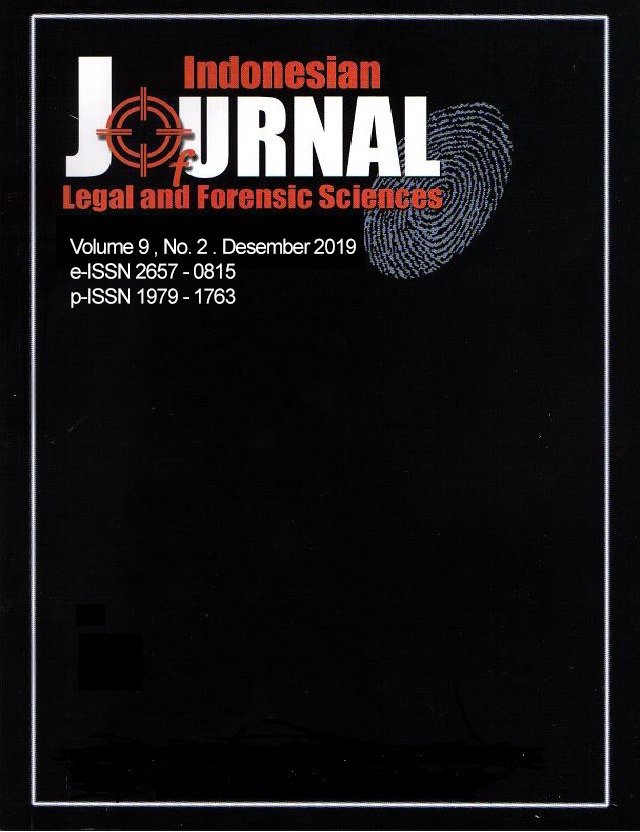Screening and Determination of Opiates in Human Urine Samples by Immunoassay and TLC-Spectrophotodensitometry
Abstract
Opiates are a class of substances, both natural and semisynthetic that have the ability to relieve pain (analgesics), put to sleep (hypnotics), and cause feelings of joy (euphoric). Repeated use will lead to tolerance (immunity to substances) and dependence. Therefore opiate class compounds besides can be used in medicine, are also very vulnerable to abuse. So that we need a method to detect the presence of opiates in biological specimens, one of which is in the urine. In this study, testing of simulated samples that have been added with certain narcotic compounds. The process of screening of compounds in the urine can be done using the immunoassay technique with a strip test. The test results showed positive for opiates. Confirmation test using TLC Spectrophotodensitometry in the TE mobile phase system (ethyl acetate: methanol: ammonia 85: 10: 5% v/v/v) and the mobile phase TAE (methanol 100% v / v) shows the confirmation of the content of opiate compounds in urine samples simulation is morphine. The next step is the determination test with TLC Spectrophotodensitometry in the TE motion system (ethyl acetate: methanol: ammonia 85: 10: 5% v/v/v) using six series solutions with different concentrations (100, 300, 500, 700, 900, and 1100 ng / µL). The resulting correlation coefficient is 0.9762, LOD is 493.24 ng, and LOQ is 1494.66 ng. In the simulation urine sample morphine levels were 25.55 ?g / mL, 17.56 25.55 ?g / mL, and 14.96 25.55 ?g / mL at three replications.
Opiates are a class of substances, both natural and semisynthetic that have the ability to relieve pain (analgesics), put to sleep (hypnotics), and cause feelings of joy (euphoric). Repeated use will lead to tolerance (immunity to substances) and dependence. Therefore opiate class compounds besides can be used in medicine, are also very vulnerable to abuse. So that we need a method to detect the presence of opiates in biological specimens, one of which is in the urine. In this study, testing of simulated samples that have been added with certain narcotic compounds. The process of screening of compounds in the urine can be done using the immunoassay technique with a strip test. The test results showed positive for opiates. Confirmation test using TLC Spectrophotodensitometry in the TE mobile phase system (ethyl acetate: methanol: ammonia 85: 10: 5% v/v/v) and the mobile phase TAE (methanol 100% v / v) shows the confirmation of the content of opiate compounds in urine samples simulation is morphine. The next step is the determination test with TLC Spectrophotodensitometry in the TE motion system (ethyl acetate: methanol: ammonia 85: 10: 5% v/v/v) using six series solutions with different concentrations (100, 300, 500, 700, 900, and 1100 ng / µL). The resulting correlation coefficient is 0.9762, LOD is 493.24 ng, and LOQ is 1494.66 ng. In the simulation urine sample morphine levels were 25.55 ?g / mL, 17.56 25.55 ?g / mL, and 14.96 25.55 ?g / mL at three replications.
Downloads
References
[2] Wirasuta, I M. A. G. Analisis Toksikologi Forensik dan Interpretasi Temuan Analisis. Indonesian Journal of Legal and Forensic Sciences 2008; 1: 47 – 55.
[3] Bnn.go.id [homepage on the internet]. Indonesia: BNN [cited 2020 Jan 10. Available from: https://bnn.go.id/penggunaan-narkotika-kalangan-remaja- meningkat/.
[4] Brunton, L.L., Chabner, B.A., Knollmann, B.C. Goodman & Gilman’s: The Pharmacological Basis of Therapeutics. 12th ed. USA: The McGraw-Hill Companies; 2011.
[5] Wolff K. Characterization of methadone overdose: clinical considerations and the scientific evidence. Ther Drug Monit 2002; 24:457-470.
[6] Wirasuta, I. M. A. G, I. A. S. Primaningrum, and K.W. Astuti. Uji Konfirmasi dan Penetapan Kadar Morfin dengan KLT-Spektrofotodensitometri. Indonesian Journal of Legal and Forensic Sciences 2014; 4: 5-7
[7] Henridrasti, V.L.S. Drug-free ASEAN 2025: Tantangan Indonesia dalam Penanggulangan Penyalahgunaan Narkoba. Jurnal Hubungan Internasional 2018; 7: 19-33.
[8] Butar, D.. Kondisi Narkoba di Indonesia Pada Akhir Tahun 2011. Jakarta : Badan Narkotika Nasional Republik Indonesia; 2011.
[9] Moffat, A. C., M. D. Osselton and B. Widdo. Clarke’s Analysis of Drugs and Poisons. 4th ed. USA: Pharmaceutical Press; 2011.
[10] Badan Narkotika Nasional. Pedoman Pemeriksaan Laboratorium Narkotika, Psikotropika dan Obat Berbahaya. Jakarta : Badan Narkotika Nasional; 2008.
[11] Manela, C. Pemilihan, Penyimpanan dan Stabilitas Sampel Toksikologi pada Korban Penyalahgunaan Narkotika, Jurnal Kesehatan Andalas 2015; 4:338-345 cit. Kerrigan, S. Sampling, Storage and Stability in : Clarke’s Analytical Forensic Toxicology. 2nd ed. Cornwall: Pharmaceutical Press; 2008.
[12] Widyastuti, N., Sulchan, M., Johan, A. Asupan Makan, Sindrom Metabolik, dan Status Keseimbangan Asam-Basa pada Lansia. Jurnal Gizi Klinik Indonesia 2013; 9:179-187.
[13] Dwi, L.Y. Narkoba Pencegahan dan Penanganannya. Jakarta: PT. Elex Media Komputindo; 2001.
[14] Gandjar, I. G. dan A. Rohman. Analisis Obat secara Spektrofotometri dan Kromatografi. Yogyakarta: Pustaka Pelajar; 2012.
[15] Ahadi, A., Partoazar, A., Abedi-Khorasgani, M. H., Shetab-Boushehri, S. V. Comparison of Liquid-Liquid Extraction-Thin Layer Chromatography with Solid-Phase Extraction-High Performance Thin Layer Chromatography in Detection of Urinary Morphine, Journal of Biomedical Research 2011; 25(5):362-367.
[16] Sherma, J. and Fried, B.. Thin Layer Chromatography. 3rd ed. New York: Marcel Dekker; 1994.
[17] Zeeuw, R.A., J.P. Franke, F. Degel, G. Machbert, H. Schutz, dan J. Wijsbeek. Thin Layer Chromatographic Rf Values of Toxicologically Relevant Substances on Standardized Systems. Jerman: VHC Verlagsgesellschaft; 1992.
[18] Skoog, D.A., Holler, F.J., Crouch, S.R. Principles of Instrumental Analysis. Seventh Edition. USA: Cengage Learning; 2018.



















